Attention! Before you begin, please read the caution in paragraph 1 this chapter.
Note: This is an initial test of the fuel and air supply subsystems of the engine management system. It is one of the preliminary checks of the entire engine management system (paragraph 3 chapter 6). It must be performed in conjunction with checking the operation of the fuel pump (paragraph 8).
Examination
1. Check the tightness of all ground wire connections to ground. Check all wires and electrical connectors that are connected to this system. Loose connections and poor ground contact can cause many defects that lead to more significant malfunctions.
2. Make sure the battery is fully charged. Accurate fuel dosing requires that the BEU and sensors be powered by a regulated voltage.
3. Check the air filter, if there is dirt in it or if it is partially blocked, this may lead to poor engine performance and reduced economy (see chapter 1).
4. If you find a blown fuse, replace it and see if it blows again. If this happens, but you need to look for a short circuit in the wiring associated with this system (see chapter 12).
5. Check the intake duct - from the air intake to the intake manifold - for leaks, which can lead to a rich mixture. Also check the condition of the vacuum hoses connected to the intake manifold.
6. Disconnect the air duct from the throttle body. Check the throttle body for dirt, carbon deposits or other deposits. If the throttle body is dirty, contact your dealers. Since the electronic control system is designed to compensate for things like deposits or dirt in the throttle body, it may be best to remove this dirt before it accumulates too much.
Note: A decal on the body warns that the body bore and throttle are coated and should not be washed with carburetor cleaner.
7. With the engine running, place a screwdriver or stethoscope on each fuel injector in turn. Listen for clicks that occur when the injectors work.
8. If any of the fuel injectors does not work or the noise from it differs from the others, turn off the engine, disconnect the electrical connector of this injector. Measure the resistance between the terminals and compare the readings with the regulated (see technical data). If it differs from the regulated, replace the nozzle.
9. Rough idle. performance degradation and/or increased fuel consumption can also be caused by clogged or dirty fuel injectors. Fuel additives, which can sometimes clean the injectors in such cases, are available from auto supply stores.
10. The rest of the system checks should be performed by dealers, as if the check is incorrect, the ECU can be damaged. The engine management system has an electrical connector. which includes a special tester.
BEU
11. Do not try to test the ECU with any equipment. If you suspect that it is defective, contact your dealers. Only if all other malfunctions have been eliminated, should a conclusion be made about the malfunction of the ECU and replace it.
Air mass meter
12. It must be checked by specialists.
Crankshaft Position/Speed Sensor
13. Disconnect the sensor electrical connector.
14. Using an ohmmeter, measure the resistance between the sensor contacts. Compare the indication with the regulated Technical requirements. If it differs from the regulated, replace the sensor.
15. Finally, connect the sensor's electrical connector.
Camshaft position sensor
16. The procedure is similar to that described above - see paragraphs. 13...15.
Coolant temperature sensor
17. see chapter 3.
Intake air temperature sensor
18. Disconnect the sensor electrical connector.
19. Using an ohmmeter, measure the resistance between the sensor contacts. Depending on the temperature of the probe tip, the measured resistance may vary, but must be within the limits specified in the Specification. If the sensor temperature changes (by placing it in the refrigerator for a while or by gently heating), its resistance should change accordingly.
20. If as a result of measurements the sensor turned out to be faulty, replace it.
Throttle Potentiometer
21. Remove the intake duct chamber (where necessary paragraph 4) and disconnect the potentiometer connector.
22. Using an ohmmeter, measure the resistance between the contacts - first between the central and one of the two outer ones, and then between the central and the other outer. The resistance must comply with the Specifications. When turning the throttle from fully closed (idling) to a fully open position, and vice versa, the resistance should change smoothly.
23. If the measured resistance differs significantly from the regulated one, as well as when an open circuit is detected or if the readings are unstable during damper operation, the potentiometer should be recognized as faulty and replaced.
Vehicle speed sensor
24. This sensor should be checked by dealers.
Steering hydraulic pressure sensor
25. Disconnect the sensor electrical connector.
26. Using an ohmmeter, measure the resistance between the sensor terminals. With the engine not rotating or at idle, when the wheels are in the straight-ahead position, the resistance at the terminals should be close to zero. When the engine is running and the steering wheel is turned all the way, the pressure in the hydraulic system increases and the sensor contacts close. The ohmmeter should show infinite resistance.
27. If the readings differ from those indicated above, then the sensor is defective and must be replaced.
Idle speed control valve
28. Where necessary, apply the parking brake, raise the front end and place it on supports.
29. Disconnect the valve electrical connector. Connect the valve terminals to a 12V battery: positive to terminal 37 and negative to terminal 21.
Attention: In order not to damage the diode inside the valve, the polarity must be observed.
A click should be heard as the contacts close and open. If you can't hear it, measure the resistance between the terminals. If it corresponds to the regulated, the valve is normal, and the malfunction may be caused by wiring or ECU. If the resistance is out of specification, replace the valve. Connect the valve connector.
Idle speed increase valve
30. Disconnect the valve electrical connector. Then apply voltage to its terminals directly from the battery. Make sure. when the solenoid is energized, the valve allows air flow, and when the solenoid is not energized, the valve is closed and no air can pass through its channels. Another way to check is to connect an ohmmeter to the valve terminals and compare its readings with those regulated in the Technical Requirements. If the valve is defective, replace it.
31. The solenoid circuit diode is designed to smooth out voltage peaks that may occur when the solenoid is turned off. Therefore, a diode failure does not cause valve failure. If you assume that the diode is still faulty, then you can check it. To do this, disconnect the diode and check it with an ohmmeter. It should only allow current to flow in one direction. If it passes current in both directions or in none of them. This means the diode is defective and needs to be replaced.
Troubleshooting
32. Various components of the systems: fuel, ignition and emission control systems are interconnected so that it is impossible to diagnose a malfunction of any component by conventional methods.
33. To detect malfunctions, the BEU has a self-diagnosis function, with the help of which component malfunctions are detected. In the event of a malfunction: the BZU identifies the malfunction, writes the corresponding code to its memory and (In most cases) switches the faulty system to a mode of operation with preset parameters stored in memory. In this mode, the car can drive to the garage.
34. All possible malfunctions are displayed using special equipment in the form of a three-digit digital code (EEC-IV) or as a message (EEC-V). When the device is connected to the diagnostic equipment through the diagnostic connector, it displays information about the malfunction.
35. Below is the troubleshooting procedure. After reading its description, decide, based on your experience and available equipment, whether it is worth doing it yourself. But even if you do not perform the troubleshooting procedure, it is not difficult to perform preliminary checks. To do this, given the information paragraph 1, follow the directions exactly. Check sequence:
- A) Perform preliminary checks (see below).
- b) Read the fault code*.
- V) Check ignition timing and base idle speed. Recheck the trouble codes to see if the problem has been fixed or not*.
- G) Perform a basic check of the ignition system components. Recheck the codes to see if the problem has been fixed or not*.
- d) Perform a basic check of the fuel system components. Recheck the trouble codes to see if the problem has been fixed or not*.
- e) If the problem persists, perform a full system check*.
Note: An asterisk indicates procedures that require special diagnostic equipment.
Preliminary checks
Note: When performing troubleshooting checks, remember that if a problem occurs almost immediately after service or repair, then it should be looked for in the service area. A malfunction can be caused by inaccurately installed components.
36. If you are looking for a reason "partial" engine malfunctions, such as incomplete realization of its characteristics, then in addition to the checks described below, check the compression in the cylinders (chapter 2A or 2B) and consider also. that a faulty hydraulic lifter can adversely affect valve clearance. Make sure the fuel filter is replaced in accordance with the service schedule.
37. If the system is completely idle, then do not forget that this may be caused by the alarm system.
38. First of all, turn on the ignition and listen to the operation of the fuel pump. The sound from the operation of the electric motor should be heard from under the rear seats. Provided that there is enough fuel in the tank, the pump should start and run for one to two seconds, and then turn off. This should happen every time the ignition is turned on. If the pump runs all the time while the ignition is on, then the electronic control system is operating in mode "hobble home". This almost certainly indicates a malfunction of the BEU itself. and therefore the car must be presented to dealers for control. In this case, do not try to test the system yourself.
39. If the pump is working properly (or not working at all), then the following checks must be made.
40. Using the diagram and sequentially inspecting the vacuum hoses and pipelines located in the 8th engine compartment, make sure that they are correctly routed and securely fastened, that they do not have cracks or other damage that cause leakage, and that they do not have kinks that reduce the internal section (see fig. 13.40, a, b). Inspect all hose connections and replace damaged or deformed hoses.
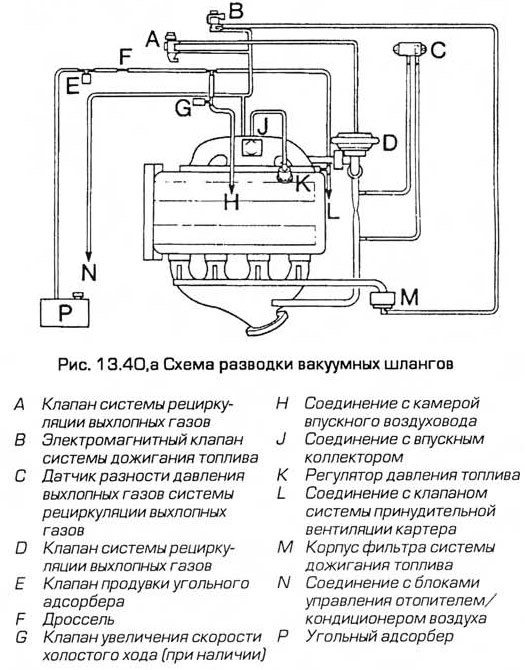
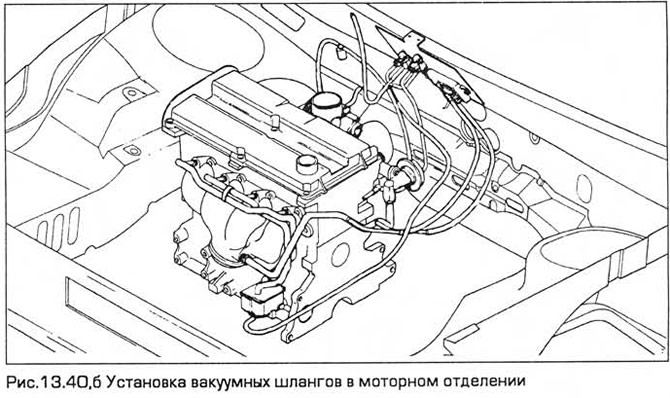
41. Inspect the fuel lines from the fuel tank towards the filter to the fuel line (discharge and drain lines). Replace sections that are leaking or damaged.
42. Make sure that the accelerator cable is securely fixed and adjusted. If you doubt its serviceability, replace the cable (see chapter 4).
43. If you suspect the throttle is not working properly, remove the intake air duct chamber from the throttle body. Make sure the throttle moves easily and smoothly throughout its travel, from fully closed to fully open and back again, while your assistant presses the accelerator pedal. If the throttle plate moves unevenly (Has the accelerator cable been checked and is good?), lubricate the throttle linkage with penetrating oil and recheck after a while.
44. Start the engine and bring it to idle. Check for leaks in the air intake duct, starting at the air intake on the inner wing panel. Leaks usually show up as a whistling sound. Small leaks can be found by spraying soapy water on the appropriate joints. A leak is detected by the appearance of an air bubble or by suction of liquid (depending on the local pressure). If a leak is found, tighten the appropriate clamp and/or replace the defective component.
45. Similarly, check for leaks in the exhaust system (paragraph 15).
46. Electrical connections can be checked by wiggling each electrical connector in turn while the engine is idling. The defective connector must be replaced. Note that this may require the entire wiring harness section to be replaced.
47. Stop the engine. If the fault is still not detected, then check the ignition voltage using an analyzer with an oscilloscope. If you do not have such a device, then you can only, by removing each spark plug in turn, check the connection and resistance of the high-voltage wire of each candle, as well as check the connections and resistances in the ignition coil. See chapter 1 and 5B.
48. The final operation of the preliminary checks is to control the level of carbon monoxide in the exhaust pipe using a gas analyzer. This operation cannot be performed without special control equipment.
Reading a fault code
Note: The following paragraph describes procedures related to the EC-IV fuel injection system (release models up to 08.1996). For fuel injection systems EC-IV and EC-V (late release models) requires a Ford 2000 fault reader that directly displays the fault without referring to the fault code.
49. The checks described above help to eliminate most engine management system problems. If the fault still persists, then connect the fault reader to the OCU.
50. The device for reading fault codes is a portable electronic device that perceives information stored in the memory of the BZU and converts it into codes displayed on the display in the form of two or three digits. The most advanced versions of these devices also allow you to control sensors and actuators. Some of these devices allow you to save information, for example, when performing a test drive, and subsequently display faults registered during the test.
51. Ford recommends using a STAR reader to test the EC-IV fuel injection system. This fault reader is used by most dealers.
52. Since the fault reading devices differ from each other, it is impossible to give an exact description of the entire sequence of checks. Therefore, you must follow the manufacturer's instructions for such a device in accordance with the code table below. The next ten paragraphs describe the procedure for reading codes by the Ford-STAR tester.
53. Before performing the procedure, you need to apply the parking brake, turn off the air conditioner and other consumers of electricity (lighting fixtures, rear window defroster, etc.). Set Neutral (manual transmissions) or choose a position "R" (automatic transmissions). If a rotating motor is to be controlled, it must be fully warmed up to normal operating temperature. Using adapters, connect the tester to the diagnostic socket of the system. On models manufactured before 08.1996, this is a triangular, three-pin connector located on the partition of the engine compartment on its right side. On later production models, the connector is located under the steering column, under a hinged plastic cover (see fig. 13.53, a-c).
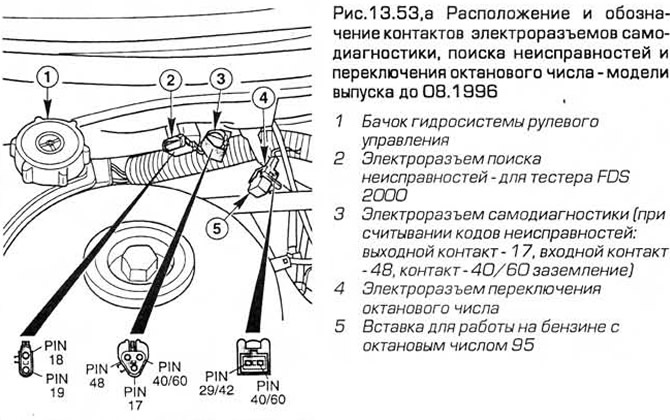
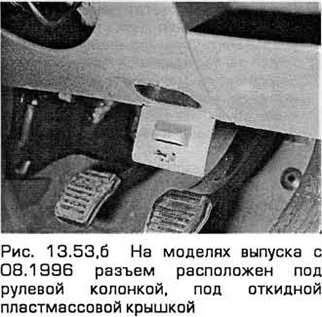
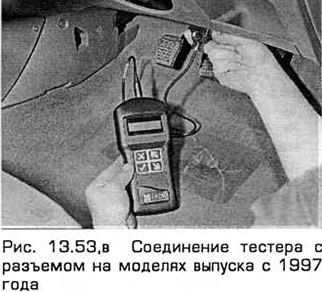
Warning: On later models, use the FDS2000 reader. The STAR tester is no good for them.
When using a voltmeter, connect its positive lead to the positive battery terminal and the negative lead to socket 17 of the diagnostic socket. Get paper and pencil ready to write down the codes.
54. Set the reader to working mode. The Ford-STAR reader will perform a display test and you will need to enter test mode parameters. The first step of the test is performed with the ignition on and the engine not running. By pressing the button "MEM/TEST" the display shows "TEST" and readiness code "000". Then the command code appears "010". The accelerator pedal must be depressed within 10 seconds of displaying this code, otherwise the tester will subsequently display faults corresponding to the codes "576" or "577".
55. After that, the tester displays fault codes, each code is repeated one more time. If there are no faults, a code is displayed "111".
56. The tester then displays the code "010" (used as separator), and after it - the fault codes stored in the memory of the BZU. If there are no faults, a code is displayed "111".
57. Working with the tester, the operator should now fully depress the accelerator pedal. The tester will test the actuators. The post-testing algorithm includes the function "shaking check", during which the operator can check the various electrical connectors as above, (in this case any fault will be logged and the corresponding code will be displayed), the function of calling the displayed codes and the function of clearing the memory of the BZU at the end of testing, when all faults are detected.
58. The next step in the case of using the Ford-STAR tester is to test the rotating engine. After setting the tester into operation (see par. 53) start the engine and bring it to idle. By pressing the key "MEM/TEST" an inscription appears "TEST", and then one of the two codes below.
59. If a warning code appears "998", followed by the appropriate fault code, turn off the ignition and check (according to display indication) coolant temperature sensor, intake air temperature sensor, mass air flow meter, throttle potentiometer and/or their respective circuits. Then repeat the test.
60. If a code appears "020", perform the following procedures within ten seconds:
- A) Fully depress the brake pedal.
- b) Turn the steering wheel all the way (in any direction), and then return it to the middle position to output a signal from the steering hydraulic pressure sensor. If such a signal is not issued, the code appears "52 G.
- V) On automatic transmission models, press and release the high gear off button, and then press and release the mode switch "economical/sporty".
- G) Wait for the code to appear "010" - delimiter. Then, within ten seconds, fully depress the accelerator pedal, rapidly increasing the engine speed above 3000 rpm and release the pedal.
61. Malfunctions detected in the 8 system are registered and displayed on the display. Each code is repeated one more time. If there are no faults, the code appears "111".
62. After displaying the codes of all registered faults, the BEU starts its program ("maintenance setup program"):
- A) The program runs for two minutes.
- b) The idle speed control valve is deactivated and the pre-programmed idle speed is entered (not regulated) meaning. If you connect the appropriate equipment, you can check the basic idle speed (but it is not regulated).
- V) The ignition setting can be checked by connecting a stroboscope (but it is also not regulated).
- G) Fully depress the accelerator pedal while performing the cylinder differential pressure test. In this case, each fuel injector is turned off in turn, and the corresponding reduction in engine speed is recorded. If the test is successful, the code is displayed "090".
- d) The program ends after two minutes. This will be noticeable by a brief increase in rpm followed by a return to normal idle speed when the idle speed control valve is activated again.
63. As with the test with a non-rotating motor, the subsequent test includes the function "shaking test", during which you can check the various electrical connectors, as indicated in paragraph 53. (in this case any fault will be logged and the corresponding code will be displayed), the function of calling the displayed codes and the function of clearing the BEU memory at the end of testing. when all faults are identified. If you use other equipment than the Ford-STAR reader, then the BEU memory can be cleared by disconnecting the battery. If this is not done, then the codes written into it will appear along with the codes registered subsequently. However, please note that disconnecting the battery will affect other memory circuits (such as clock and audio unit). If the battery needs to be disconnected to service other parts of the vehicle, first check to see if any trouble codes are registered.
64. Below is a table with fault codes. It also provides a breakdown of the codes and what to do if the codes are displayed.
| Code | Meaning | Action |
| 000 | Ready for testing | - |
| 010 | Command Code/Code Separator | Fully depress and then release the ax-ra pedal |
| 020 | Command code | Fully depress and then release the brake pedal |
| 10 | Low pressure in cylinder #1 | When checking the pressure difference in the cylinders |
| 20 | Low pressure in the cylinder. #2 | When checking the pressure difference in the cylinders |
| 30 | Low pressure in the cylinder. No. 3 | When checking the pressure difference in the cylinders |
| 40 | Low pressure 8 cylinder. #4 | When checking the pressure difference in the cylinders |
| 90 | Checking the pressure difference in the cylinders - normal | - |
| 111 | No faults found | - |
| 112...114 | Intake air temperature sensor | Check Component (see above) |
| 116...118 | Temperature sensor, cooling liquids - dvig. not warmed up to standards, working temp. | If faulty maintained at normal operating temperature, check the component (chapter 3) |
| 121...125 | Throttle Potentiometer | Check Component (see above) |
| 129 | Incorrect air flow signal when performing check | Repeat check |
| 136,137 | Oxygen sensor | Check Component (chapter 4B) |
| 139 | Oxygen sensor | Check Component (chapter 4B) |
| 144 | Oxygen sensor | Check Component (chapter 4B) |
| 157...159 | Air mass meter | Check Component (see above) |
| 167 | Incorrect potential signal dros. honored when performing a check | Repeat check |
| 171 | Oxygen sensor | Check Component (chapter 4B) |
| 172 | oxygen. sensor - mixture too lean | Check Component (chapter 4B) |
| 173 | oxygen. sensor - rich mixture | Check Component (chapter 4B) |
| 174,175 | Oxygen sensor | Check Component (chapter 4B) |
| 176 | oxygen. sensor - mixture too lean | Check Component (chapter 4B) |
| 177 | oxygen. sensor - rich mixture | Check Component (chapter 4B) |
| 178 | Oxygen sensor | Check Component (chapter 4B) |
| 179 | Fuel system too lean | Check the RVG system valve (chapter 4B) |
| 181 | Fuel system - reenriched mixture | Check the RVG system valve (chapter 4B) |
| 182 | Idling - mixture too lean | Check control valve. speed cold move (see above) |
| 183 | Idling - rich mixture | If the mixture is correct, check the fuel system (see below) |
| 184,185 | Air mass meter | Check Component (see above) |
| 186 | Fuel injector opening interval too long | Check system (see below) |
| 187 | Fuel injector opening interval too short | Check system (see below) |
| 188 | oxygen. sensor - mixture too lean | Check Component (chapter 4B) |
| 189 | oxygen. sensor - rich mixture | Check Component (chapter 4B) |
| 191 | Idling - mixture too lean | Check the RVG system valve (chapter 4B) and control valve speed cold move (see above) |
| 192 | Idling - rich mixture | Check the RVG system valve and control valve. idle speed (chapter 4B) |
| 194.195 | Oxygen sensor | Check Component (chapter 4B) |
| 211 | The ignition signal does not enter the BEU | Check system (see below) |
| 212 | Tachometer circuit | Check system (see below) |
| 213 | The ignition signal does not come from the ECU | Check system (see below) |
| 214 | Camshaft position sensor shaft | Check Component (see above) |
| 215...217 | Ignition coil | Check system (see below) |
| 218,222 | Tachometer circuit | Check system (see below) |
| 226 | BEU / ignition module signal | Check system (see below) |
| 227 | crankshaft position sensor | Check Component (see above) |
| 228 | Ignition module/winding 1 coil | Check system (see below) |
| 229 | Ignition module/winding 2 coils | Check system (see below) |
| 231 | Ignition module/winding 3 coils | Check system (see below) |
| 232 | Primary windings of the ignition coil | Check system (see below) |
| 233 | ignition module | Check system (see below) |
| 234...237 | Primary windings of the ignition coil | |
| 238 | Ignition Module/Ignition Coil Primaries | Check system (see below) |
| 239 | The ignition signal does not enter the BEU when the engine is rotating | Check system (see below) |
| 241 | Incorrect signal from the BEU and / or the ignition module when performing. checks | Repeat check |
| 243 | Ignition coil failure | Check system (see below) |
| 311...316 | Fuel afterburning system | Check system (see below) |
| 326 | Exhaust pressure difference sensor in the RVG system | Check Component (chapter 4B) |
| 327 | Exhaust pressure difference sensor or solenoid valve in the RVG system | Check Component (chapter 4B) |
| 328 | Solenoid valve of the RVG system | Check Component (chapter 4B) |
| 332 | RVG valve does not open | Check Component (chapter 4B) |
| 334 | Solenoid valve of the RVG system | Check Component (chapter 4B) |
| 335 | Exhaust pressure difference sensor in the RVG system | Check Component (chapter 4B) |
| 336 | Exhaust gas pressure too high | Check Component (chapter 4B) |
| 337 | Exhaust pressure difference sensor or solenoid valve in the RVG system | Check Component (chapter 4B) |
| 338,339 | Temperature sensor, cooling liquids | Check system (see below) |
| 341 | Maintenance connector grounded | Disconnect the connector, repeat the test and reconnect the connector |
| 411 | Check engine speed is too low | Check for air leaks, then recheck |
| 412 | Check motor speed too high | Check for air leaks, then recheck |
| 413...416 | Speed control valve | Check Component (see above) idle move |
| 452 | Engine speed sensor | Check Component (chapter 6 paragraph 4) |
| 511,512 | BEU memory block | Check if the battery is disconnected, then check fuse 11, if the fault persists, replace the BEU (par.14) |
| 513 | BEU reference voltage | Check system (see below) |
| 519,521 | Steering hydraulic pressure sensor does not work during test | Make sure the component is installed and connected, then check again, if the problem persists, check the entire system (see below) |
| 522,523 | Selector position sensor | Check Component (chapter 7B) |
| 536 | Brake pedal microswitch does not work during test | Repeat check |
| 538 | Operator error during verification | Repeat check |
| 539 | When checking, the air conditioner is turned on | Turn off and retest |
| 542.543 | Fuel pump circuit | Check system (see below) |
| 551 | Idle speed control valve circuit | Check system (see below) |
| 552 | Fuel afterburning system | Check system (see below) |
| 556 | Fuel pump circuit | Check the fuel pump relay, if the problem persists, check the system (see below) |
| 558 | Electric circuit valve system RVG | Check system (see below) |
| 563 | Relay and/or electric fan circuit (high speed mode) radiator | Check system (see below) |
| 564 | Turnip and/or Radiator Fan Circuit | Check system (see below) |
| 565 | Carbon adsorber solenoid valve | Check Component (chapter 4B) |
| 573 | Radiator fan relay and/or circuit | Check system (see below) |
| 574 | Relay and/or electric fan circuit (high speed mode) radiator | Check system (see below) |
| 575 | Fuel cut switch and/or fuel pump circuits | Check system (see below) |
| 576,577 | When checking, the accelerator pedal is not fully depressed - the automatic transmission downshift device does not work | Repeat check |
| 621 | Automatic Transmission Shift Solenoid 1 Circuit | see chapter 7B |
| 622 | Automatic Transmission Shift Solenoid 2 Circuit | see chapter 7B |
| 624 | Automatic transmission pressure control solenoid | see chapter 7B |
| 625 | Automatic Transmission Pressure Control Solenoid Circuit | see chapter 7B |
| 629 | Automatic transmission torque converter solenoid | see chapter 7B |
| 634 | Selector Position Sensor Circuit | Check Component (chapter 7B) |
| 635,637 | Automatic Transmission Fluid Temperature Sensor | see chapter 7B |
| 639 | Automatic transmission speed sensor | see chapter 7B |
| 645 | 1st gear automatic transmission | see chapter 7B |
| 646 | 2nd gear automatic transmission | see chapter 7B |
| 647 | 3rd gear automatic transmission | see chapter 7B |
| 648 | 4th gear automatic transmission | see chapter 7B |
| 653 | Top gear off button and mode switch "Economy/Sport" automatic transmission does not turn on when checking | Repeat check |
| 998 | Warning code | Check for malfunctions indicated by the following codes |
Checking the ignition timing and base idle speed
Note: Both parameters are controlled by the ECU. The ignition timing is not adjustable at all. The basic idle speed is set at the factory and cannot be changed.
65. If after reading fault codes (and performing appropriate checks) If the fault persists, the next step is to check the control by means of the LCU of the two above parameters. This requires a Ford-STAR tester, as well as an accurate tachometer and high quality strobe. Without this equipment, the test cannot be performed.
66. Before performing the procedure, you need to apply the parking brake, turn off the air conditioner and other consumers of electricity (lighting fixtures, rear window defroster, etc.). Set Neutral (manual transmissions) or choose a position "R" (automatic transmissions). Start the engine and wait until it warms up to normal operating temperature. The radiator fan must be constantly rotating during the test. The tester will report on its inclusion from the BEU.
67. Raise the front and securely fix it on the supports. Remove the accessory drive belt cover (Chapter 1). Paint two pairs of notches on the inner and outer rims of the crankshaft pulley with white paint. Please note that the pulley is not marked with reference marks corresponding to the ignition timing. In the case of clockwise rotation of the crankshaft, the first pair of marks is not used for the vehicles shown in this manual. The second pair of marks indicates the TDC if it is aligned with the rear edge of the relief mark applied to the pallet. When checking the ignition timing, the rear edge of the mark on the pallet must be located directly in front of the TDC marks.
68. Start the engine and bring it to idle. Practice the test with the engine running until the BEU enters the program "maintenance settings".
69. Using a stroboscope, check the alignment of the marks, as mentioned above, at idle speed. If the labels do not align as indicated, then there may be a problem with the system and a full system test must be performed to identify it (see below).
70. Use a tachometer to check the base idle speed and compare it to specifications.
71. If the speed reading is significantly different from the regulated one, check for air leaks (preliminary checks, see above) or the presence of other faults that may be causing this.
72. Base idle speed set at factory with air bypass screw (mounted in the right front corner of the throttle body). This screw controls the amount of air passing through the bypass circuit around the throttle when it is fully closed at idle. This screw is sealed with a safety cap (see fig.13.72). During maintenance, the idle speed is controlled by the BEU. BEU has the ability to compensate for factors that may require a change in idle speed - such as engine wear, dirt deposits in the throttle body, and others. Therefore, the position of this screw cannot be changed. If its position has been changed, then a blue safety cap must be installed on the screw, and the engine must be brought to idle mode and kept on it for at least five minutes, so that the BEU enters idle parameters in learning mode.
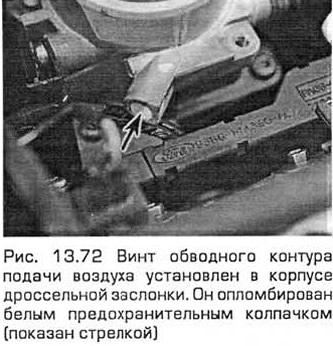
73. Upon completion of both checks and the end of the program "maintenance settings" follow the tester instructions and see if the problem is fixed or not.
Basic check of the ignition system
74. If, as a result of the previous checks, the malfunction has not been eliminated, then the next step is a basic check of the components of the ignition system using an analyzer with an oscilloscope. If you do not have such equipment, then you can only test the connections and resistances of the high-voltage wires of the spark plugs and the connections and resistances of the ignition coil by removing each spark plug in turn. See chapter 1 and 5B.
Basic fuel system check
75. If as a result of the previous checks the malfunction has not been eliminated, proceed to the next step - a basic check of the fuel system components.
76. Provided that the fuel pump is working properly (according to the results of preliminary checks), the fuel filter is not clogged and there are no leaks in the system, the next step is to check the fuel pressure (paragraph 7). If OK, check fuel injectors (see above in this paragraph) and forced crankcase ventilation system (Chapter 1).
Checking the entire system
77. The last stage of the verification procedure is the verification of the entire system using a special device that is connected between the BEU and its electrical connector. In this case, the specific circuits indicated by the fault codes can be tested while connected to the system and. if necessary, with the motor running. In this case, the output signal of many system components can be measured for a more thorough check.
78. In addition to such a device and adapters, special elements are required for this test. This check must be performed by dealers.
Idle speed and mixture
79 These parameters are not adjusted manually, they are controlled by the ECU. Parameter settings can only be checked using special diagnostic equipment.
80. If you suspect that these parameters are not normal, contact your dealers to check the entire system.
81. On models with a heated windshield, an idle speed boost valve is installed. It increases speed to compensate for the increase in engine load when the heater is turned on. When the valve is open, air from the intake duct chamber flows bypassing the throttle and idle speed control valve directly into the intake manifold through a connection on its left edge. Once this system is turned on, it will only operate for four minutes while the heater circuit is energized. The BEU controls it in addition to the main idle speed control.
Visitor comments